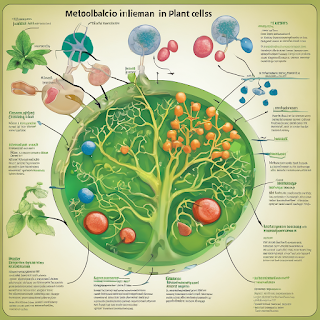Metabolomics in the Garden: Tracking Plant Biochemistry through Omic Technologies
As an avid gardener, I'm always fascinated by the intricate processes happening beneath the soil and within my plants' leaves, stems and flowers. How do all the biochemical reactions work together seamlessly to fuel growth, defense and reproduction? For decades, scientists have been teasing apart these inner workings piece by piece.
Now, new fields like metabolomics are providing a powerful systems-level view by tracking small molecule metabolites - the end products and fuel for life. When combined with other "omic" technologies, metabolomics is transforming what we know about plant biochemistry.
Tracking Plant Biochemistry with Metabolomics
Metabolomics is an exciting new field that uses advanced analytical techniques to detect and quantify all the small molecule metabolites in a biological sample. When applied to plants, it provides insights into biochemical pathways and processes and how they respond to changes. Combining metabolomics with other "omics" like genomics, transcriptomics and proteomics creates an even more powerful multi-omic view of plant systems.
This integrated approach is revealing intricate networks linking an organism's genes and proteins to functional outcomes like growth, defense and environmental interactions. As technologies continue advancing, metabolomics holds promise for improving our understanding of plant biochemistry and informing crop breeding or biotechnology applications. Overall, the omics revolution is transforming what we can learn about the molecular inner workings of the green world around us.
Metabolomics Unveiled: Decoding the Biochemical Symphony of Plant Life
Metabolites are the molecules and chemicals produced through metabolic pathways in an organism. Ranging from amino acids to hormones to pigments, they represent the final outputs of thousands of interconnected biochemical transformations. By profiling all the metabolites present in a biological sample, metabolomics gives a functional snapshot of the system's biochemical state. While genes, RNA and proteins provide information about an organism's molecular architecture and regulatory networks, metabolites directly reflect its physiological condition and activity. Metabolomics allows researchers to observe metabolic pathways in action, monitor biochemical changes and identify novel small molecules - insights not possible from any other single "omic".
When integrated with other omics approaches, metabolomics paints an even clearer picture. For example, combining it with transcriptomics via RNA sequencing lets scientists see how gene expression regulates metabolic pathways. They can observe correlations between specific transcripts and metabolites to map out regulatory interactions. Pairing it with proteomics, which identifies all the proteins expressed, provides another layer of context. Proteins are the enzymes catalyzing metabolic reactions, so proteomics helps link genotypes to phenotypes through metabolic functions. By considering metabolites together with other molecular data from the same biological samples, researchers gain a powerful systems view of plant biochemistry in health, stress, development and more.
Beyond Single "Omic": Multi-Omic Metabolomics Revolutionizing Plant Biochemistry
This multi-omic metabolomics is illuminating complex biochemical networks in important crop plants. One study applied it to understand potato tuber development and storage carbohydrate accumulation and mobilization. By integrating metabolite, protein and transcript profiles throughout tuber growth, researchers uncovered previously unknown genetic regulators of starch and sugar metabolism. Another applied multi-omics to dissect maize kernel development, identifying coordinated changes across metabolites, proteins and transcripts. This is helping scientists engineer varieties with optimized starch or oil contents. Excitingly, metabolomics is also enhancing our understanding of plant-microbe interactions through the rhizosphere. By considering root exudates and small molecules exchanged in symbiosis or pathogenesis, it provides a biochemical perspective on these relationships.
Looking ahead, as metabolomics technologies advance and more plant species are profiled, its potential seems limitless. Combined with other omics approaches, it will continue revolutionizing our view of plant biochemistry, from cellular processes to whole organism physiology and environmental interactions. Whether exploring stress responses, specialization across plant structures, or adaptations in extreme environments, metabolomics provides a direct readout of biochemical functions. For plant scientists and breeders, it opens new doors to enhance traits and develop more sustainable varieties through a deeper understanding of metabolic networks. And for curious gardeners like myself, it sheds more light on the intricate chemistry sustaining the diverse and wondrous plant kingdom.
Probing Plant Biochemistry
Metabolites are small molecules like hormones, lipids and secondary compounds that plants produce through metabolic pathways. These biochemicals influence key functions from stress responses and nutrient allocation to growth, development and defense against threats.
Traditional methods could only analyze a few metabolites at a time, missing their complex interactions as integrated systems. Metabolomics analyzes hundreds of metabolites present in a plant sample simultaneously using analytical techniques like mass spectrometry and NMR. This reveals which metabolic pathways are actively expressed based on conditions.
For example, one study identified over 100 stress-related metabolites in drought-stressed rice, providing clues to breed varieties with enhanced tolerance naturally. Characterizing dynamic metabolic networks' responses to management practices provides understanding to optimize resilience through ecological intensification.
Potential Applications for Farmers
For smallholders, metabolomics offers hope to develop crop varieties and production systems naturally resilient to stresses with minimal external inputs. Participatory analyses of on-farm trials may guide locally-adapted soil and crop stewardship tailored to climate vulnerabilities.
Regional networks of farmers, researchers and extension agents could collaborate utilizing shared metabolomics infrastructure and bioinformatics support. With appropriate safeguards, this powerful knowledge holds promise to truly empower small-scale food producers as effective stewards of agrobiodiversity and ecosystem services underpinning resilience.
The Road Ahead
Excitingly, initial projects applying metabolomics to on-farm research are already underway. By directly involving smallholder cooperatives, these initiatives aim to strengthen agroecosystem functions through ecologically-based intensification.
Looking ahead, continued open yet evidence-based discourse around technical, ethical and regulatory considerations will be important to maximize benefits and address concerns proactively. With care and responsibility, 'omics approaches like metabolomics hold tremendous potential to revolutionize agroecology and food security when guided by farmers as equal partners.
In closing,
an inclusive process respecting diverse perspectives is key. Sustainability depends on nurturing both people and planet through cooperative efforts recognizing our shared well-being. The journey ahead exploring life's secrets is an exciting one if we walk it together in trust and care for one another.

Post a Comment